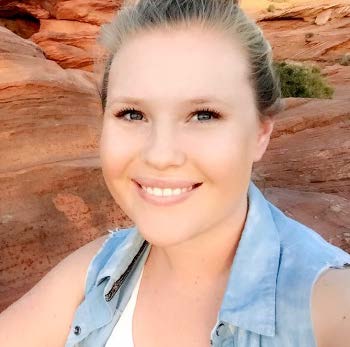East Central University student Tara Sloan underwent a unique summer internship experience in Arizona with the Junior Commissioned Officer Student Training and Extern Program (JRCOSTEP).
The senior environmental health science major from Ft. Worth, Texas, immersed herself in various projects while serving as an intern with the Indian Health Service, an operating division of the United States Public Health Service at the Phoenix Area Office.
“ECU provided me with a profound understanding of environmental health,” Sloan said. “I was excited to take everything I have been taught over the past few semesters and apply it to the work setting.”
As part of the Institutional Environment Health (IEH) program, the Phoenix office provides health care and community health services to approximately 140,000 American Indians/Alaska Natives in Arizona, Nevada and Utah.
According to Sloan, IEH assists the community health program with the inspection of complex community institutions such as industrial plants, schools with shops, correctional facilities and dialysis centers.
“I worked closely beside my Preceptor Captain Dave Cramer, who gave me a great introduction to the IEH program through multiple visits to complex IEH facilities,” said Sloan. “Over the summer, I participated in NFPA Life Safety Code surveys, OSHA surveys, food service inspections, swimming pool inspections, ventilation surveys, OSHA training and vector disease surveillance. I also managed the calibration of the program’s IH equipment.”
One of several projects assigned to her was to distribute the “Safety Officer Resource Guide,” a go-to resource for safety personnel at healthcare facilities and EH officers in the field. The guide includes common OSHA regulations, joint commission EC standards, NFPA references and formalizing and distributing the guide.
“I am proud to have worked on this documents as it provides safety personnel with a very useful and efficient quick reference,” Sloan said.
Another of her projects was assisting in conduction an OSHA survey of a carbon regeneration facility. The facility regenerates carbon used in filtration systems (i.e. water waste treatment and air emissions control). Spent carbon filter media is transported to the facility by truck where the carbon contaminants are characterized by laboratory analysis.
According to Sloan, carbon is mixed with water and heated to desorb the chemical contaminants. Some of the examples of the chemicals reported include benzene, toluene, ethylbenzene, xylene (BTEX) and trichloroethylene (TCE).
“One of the key findings we discovered while conducting the inspection was that one of their outdoor eye wash station’s water temperature measured at approximately 120 degrees Fahrenheit. This was due to the plumbing being exposed to sunlight and ambient temperatures exceeding 100 degrees,” said Sloan. “Water exceeding 100 degree Fahrenheit can not only damage the cornea, it can enhance the chemical reaction as opposed to flushing it out of the eyes.”
A recommendation was made that the facility work with a certified plumber to determine how to bring immediate tepid water to the eyewash station.
Another one of her tasks this summer was assisting Cramer train a hospital maintenance mechanic on the ventilation on the ventilation survey process.
“The training included how to properly use the equipment needed to check air flow, conduct surveys on the hospital isolation rooms as well as calculate air changes per hour (ACH),” Sloan said. “The equipment we used were the Balometer (measures air flow), VelociCalc (measures air flow in places that are difficult to reach) and smoke tubes (verifies pressure relationships between isolation rooms and corridors).”
Being able to determine pressure relationships and ACH is crucial to patient and staff safety, according to Sloan.
“For example, airborne isolation rooms must have a negative pressure to ensure that whatever airborne contaminant is in that room is not being spread to the rest of the hospital,” said Sloan. “Whereas, in an operating room there needs to be positive pressure to ensure sterilization and prevent infection. By the end of the day, the maintenance mechanic demonstrated a high degree of competence with these tasks.”
Additionally, Sloan was able to perform West Nile Virus surveillance on the Hopi Reservation, where mosquito traps were placed throughout the reservation at dusk, which was optimal time for mosquito activity.
“The traps we used utilized a battery-powered, down-draft fan and dry ice. As dry ice melts, it releases carbon dioxide into the atmosphere, which attracts the mosquitos,” Sloan said. “Once the mosquitoes fly into the trap, the fan prevents them from escaping and they are collected the next morning for analysis.”
Sloan believes this internship will not only be a benefit toward her environmental health science career, but it gave her the opportunity to experience various Native American cultures and customs.
“I couldn’t have asked for a more unique, humbling, educational and fulfilling internship. I strongly encourage anyone who has an interest and a passion for environmental health to apply for the JRCOSTEP internship,” said Sloan. “It’s a once in a lifetime experience that I promise you will be talking about for the rest of your life. I cannot put into words how thankful I am to have had this experience.”
Sloan highly recommends ECU’s Environmental Health Science Program to students interested in protecting the natural environment and human health.
“The EHS program is very unique and the professors go above and beyond to better their students,” Sloan said. “The program focuses on many different topics in environmental health science and it’s prepared me for my career.”
-ECU-

